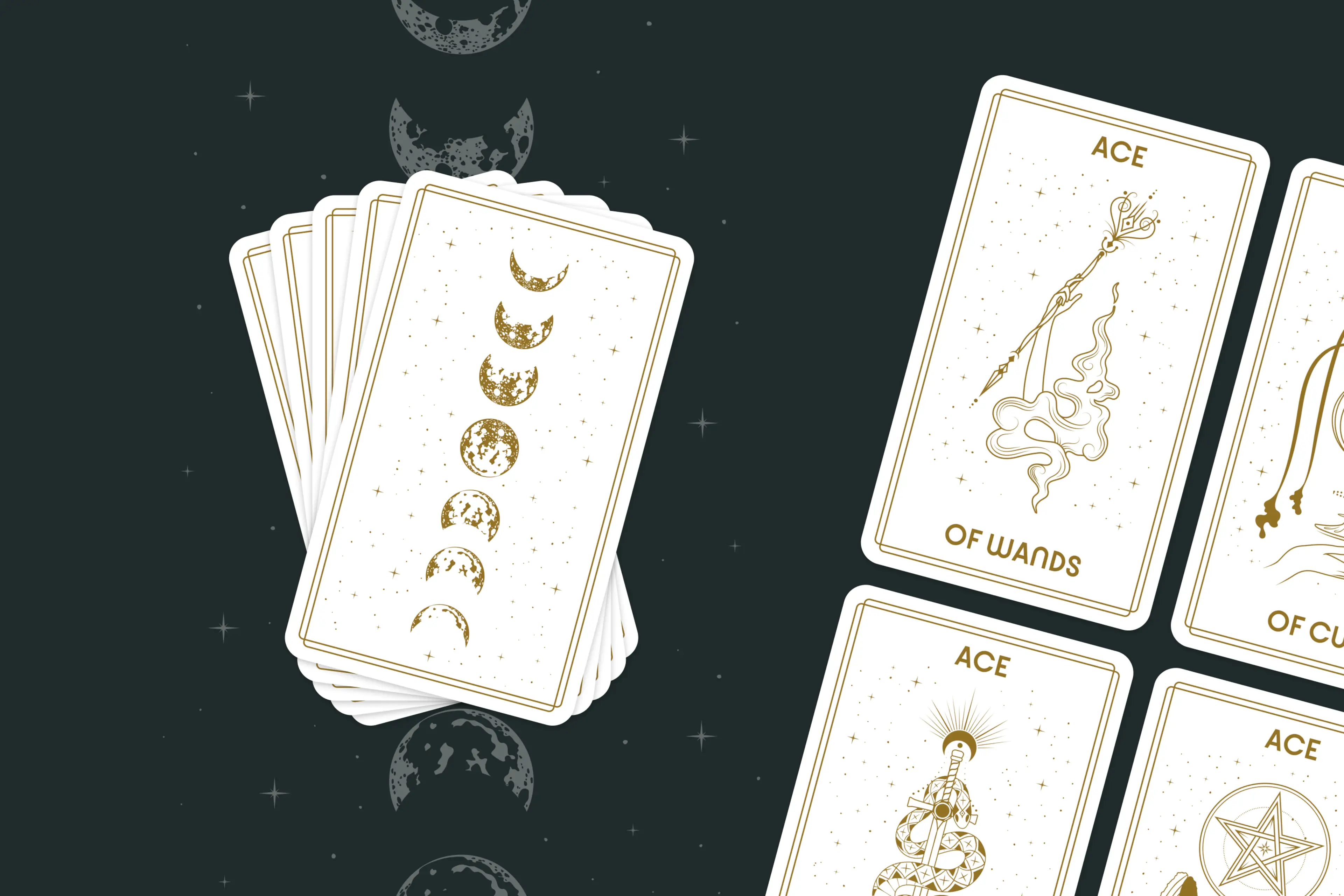The 56 Minor Arcana cards, which correspond to the standard four suits of a playing card deck and pre-date the Major Arcana, form a four-fold narrative through the suits, with each suit corresponding to an element and a domain of human life: Cups cards (water/emotion), Wands cards (fire/energy), Swords cards (air/the mind), and Pentacles cards (earth/resources).
Like the four cardinal points on a compass or the four elements, each suit indicates a field of activity that mirrors our internal and external daily experience. Whereas the Major Arcana cards describe significant themes and fundamental lessons experienced by all, the Minor Arcana cards reflect the nuances of our everyday experiences, habits, thoughts, and emotions.
In 1909, when Pamela Colman Smith was commissioned to illustrate a new deck of Major and Minor Arcana tarot cards for Arthur Edward Waite, she breathed new life into the Minor Arcana cards by illustrating them with figurative scenes. The resulting Rider-Waite tarot deck was the first to feature Minor Arcana cards with figurative illustrations since the 15th-century Sola-Busca deck, which inspired Smith’s artwork.
The Rider-Waite deck is distinct from oracle decks, and is ideal for beginners who want to learn tarot and seasoned tarot readers alike.
The Four Minor Arcana Suits
Each suit contains 14 numbered cards, from Ace to 10, plus four court cards: Page, Knight, Queen, and King. In tarot readings, the 56 Minor Arcana represent four domains of daily human experience and archetypal expressions of personality, while the 22 Major Arcana represent significant life events, themes, and spiritual lessons.
Suit of Wands
Wands (fire): The Wands speak to our life force, vitality, and the ways that we manage our energy in service of our creativity, ambition, and desire for personal growth. They illustrate the task of keeping our inner spark alive amidst self-doubt, disappointment, creative challenges, and exhaustion.
Suit of Cups
Cups (water): The Cups relate to our feelings, intuition, emotional connections, and the ways that our relationships serve to support our growth and development. The suit describes challenges around discerning what brings true emotional fulfillment, reckoning with loss, and the ways that our relationships amplify both our joys and our pain.
Suit of Swords
Swords (air): The Swords relate to our mental realm, beliefs, communications, and the ways that the mind can be a tool for clarity, truth, logic, and decision-making. The suit describes how the mind can be a double-edged sword that can either aid us in cutting through illusion or otherwise turn on itself through limiting beliefs, anxieties, rumination, and regret.
Suit of Pentacles
Pentacles (earth): The Pentacles relate to the material realm and the physical and energetic resources we have to support our livelihoods, health, and our work in the world. The suit describes challenges around building self-worth, material security, and the ways that we can channel our energy in service of our long-term stability and security.
Numbers in the Minor Arcana
Aces
The Aces mark the beginning of the suit and represent a seed of potential, a new opportunity, and a shift of energy. The Aces share a visual motif of a hand appearing from the clouds as if to offer a gift or blessing related to the suit.
Middle Cards (2-10)
Twos: The Twos present the emergence of duality, which builds on the new beginning presented in the Ace. Here, growth is possible through relationships, self-reflection, and decisions around how to best use one’s time and energy in service of one’s goals.
Threes: The Threes present growth and expansion through creativity, as the synthesis of two discrete elements creates a novel third possibility. Progress, movement, and healing are possible through synthesis and integration.
Fours: Like the Four legs that support a table, the Fours represent balance, order, and structure. They offer the stability necessary to pause, reflect, gather one’s resources, and ground one’s energy for the journey ahead.
Fives: The Fives introduce an element of conflict, challenge, or precariousness to the stability established in the Fours. The Fives compel us to grow through confronting internal and external challenges, which eventually spur us to action.
Sixes: Following the instability of the Fives, the Sixes present scenes of rebalancing, harmonizing, and the establishment of peace within a time of transition. They encourage reflection on the past in order to clarify one’s future direction, and they present the possibility of a successful period of growth.
Sevens: The Sevens compel us to assess and evaluate our progress up to this point and to strategize the best plan of action given the current challenges from the inner or the outer environment. They present the opportunity for growth through inner work.
Eights: The Eights represent a time of movement and progress toward one’s goals and a period of transformation that is either catalyzed by a deepening of one’s dedication and commitment to a path or, otherwise, leaving the known in search of greater fulfillment.
Nines: The Nines represent projects coming to fruition, a sense of fulfillment and attainment, and questions around what brings an emotional and physical sense of security and protection.
Tens: The Tens are the culmination of their suit and represent completions, endings, and realizations. The Tens depict the closing of a chapter and hold the seeds of renewal through the successful manifestation of dreams or the willingness to find closure around painful endings.
Court Cards
The Court Cards of the Minor Arcana represent archetypal (rather than literal) personality traits and expressions of age, gender, and stages of maturity. Together they can be understood as representing four stages of development of a process, quest, or journey.
Pages: The Pages represent the energy of youthful curiosity, exploration, and the desire for learning and expansion and embody the naiveté and the courage required to begin something new. In the stages of a quest or process, the Pages can be seen as the stage of conceptualization.
Knights: The Knights represent forward movement, change, and a willingness to take risks in pursuit of a cherished goal or dream. A shared trait of each Knight is the tendency towards excess (or stagnancy) if the energy is not properly channeled, considered, or focused. In the stages of a quest or process, the Knights can be seen as the stage of initiatory action.
Queens: The Queens embody archetypally feminine qualities such as relational maturity and the ability to nurture oneself and others. They are aligned with yin ways of relating, which can be seen as passive, or having the ability to magnetize what one needs toward them. In the stages of a quest or process, the Queens can be seen as the stage of nurturing and stabilizing.
Kings: The Kings represent archetypally masculine energy and the yang, or outwardly-directed active principle that has the capacity to actualize the energy of the suit through focused action and grounded leadership. In the stages of a quest or process, the Kings can be seen as the stage of development and completion.

